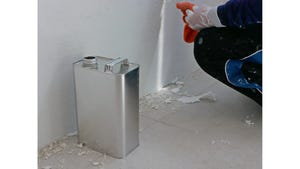Compact Vibratory Screeners Help Maximize Production
September 14, 2006
Manufacturers in every field are keeping their processes private, if not secret. After all, most processes are in some ways proprietary, comprising a mix of methods, technologies and operations that ultimately affect a manufacturer’s ability to compete successfully. This is certainly not lost on the paint and coatings sector, where both products and processes may be highly proprietary.
If no one is talking, how does a plant manager know if his process is outdated or if process components are lacking flexibility, crippling productivity or resulting in unnecessary expenditures? By comparing notes and manufacturing similarities when the opportunity presents itself, whether a source is entirely on record or not.
One of the best-kept secrets in the manufacturing sphere, for instance, is a new generation of vibratory compact screeners. Screening is an essential process for many manufacturers and can be especially vital to those involved with paint and coatings, whose end product and production efficiency depend on getting this step right.
The benefits of using vibratory compact screeners were so significant at a major paint and coatings applicator in the auto industry that management decided not to go on record. Yet an outline of the process and its results may prove helpful for those facing similar challenges.
Optimizing Paint and Primer Application
When a major paint and coatings applicator recently won a contract to build mass production automobile paint primer shops for one of the world’s largest automakers, it faced a daunting task.
A standard wet spray primer paint system was ruled out for cost, performance and environmental reasons. Since wet spray is solvent based, any paint that doesn’t adhere to the auto body has to be captured and ends up as costly waste to be disposed of. The go-ahead was given for a more durable, cost-effective, powder-based primer system in which overspray can be reused instead of becoming an environmental liability.
But to deliver its benefits, the powder application system had to meet rigorous quality and production specifications.
“For proper flow through small orifices such as applicator guns and valves, as well as to prevent visible defects on the primer coat after curing, the powder must be screened so nothing larger than 105 microns gets through,” said an engineer responsible for automotive powder application on the project.
Screening to 105 microns was complicated by the tendency of the raw virgin powder to clump before delivery to the hoppers for transport to the powder applicators. Screening was also critical to remove any debris or contaminants from reconditioned powder before re-use.
“To maintain the necessary quality and reliability, the powder must be pharmaceutical grade clean,” explains the engineer. “Any particles above 105 microns can cause blockage or blinding. This could stop production or require pulling a vehicle off-line for spot paint repair and re-application.”
Though powder primer application got its start in the automotive industry nearly a decade ago, its full acceptance has been hampered until recently by screening deficiencies requiring undue downtime and production space.
Initially, typical screeners used in powder primer application required an electronic sensing device to detect if they had blocked and needed servicing. Such screeners only ran about two hours before having to be returned to the manufacturer for cleaning and inspection. This stopped production during screen change out.
Because typical screeners have been large, they not only presented more surface area for clogging but also occupied more production floor space for installation. These larger installations required bigger, costlier rooms with more environmentally controlled airspace, since the powder used in primer application must be temperature and humidity regulated.
Compact Screener Solution
To avoid these problems, the automotive paint and coating applicator chose a new generation of high-capacity, 36-in. compact screeners with Vibrasonic deblinding systems from Russell Finex of Pineville, NC.
Screening is an essential process for many manufacturers and can be vital to those involved with paint and coatings, whose end product and production efficiency depend on getting this step right.
The engineer says the compact screeners, developed to maximize cleaning efficiency, are suitable for powder paint and primer application. Due to their highly efficient powder flows, blinding sensors are not required on the Russell screeners used for primer application to auto bodies.“Unlike standard screeners shaken by an electric motor, the Vibrasonic screeners sonically vibrate at high frequency in conjunction with the motor harmonics,” explains the engineer. “They’re engineered to flow oversized particles toward a vacuum pickup, which keeps them clean and extends service life.”
“Because of their extended service life, inspection can be done every shift or two, which eliminates production stoppage for screener changeout every few hours,” he says. “That’s the equivalent of gaining an extra hour of production each day. It also dramatically cuts the capital cost of sending out the screeners for professional cleaning.”
Small Size Maximizes Production
When retrofitting a spray primer system to powder application, the engineer found the Russell compact screener’s small size a benefit in maximizing production line real estate. A smaller 15-in. unit proved to be what was needed.
“Everything fights for space on the production floor—from pumps, pipes, filters and automation to electrical controls, fire protection and supervisory space,” says the engineer. “That’s where the Vibrasonic screener’s compact size is so valuable.”
Because of the unit’s compactness, we were able to locate it below a gravity-fed bulk sack unloader. This eliminated the need for a conveyor and transfer pump, which saved valuable production space and capital.”
The engineer adds that while some screeners have commercial hardware such as nuts and springs exposed to the material being screened, the Russell unit does not, thereby eliminating the risk of hardware vibrating loose and entering the product stream. He appreciates also that the units are essentially dust and spark proof, with class 2, division 2 electrical classification.
Beyond the production primer shops, the paint and coatings applicator has loftier goals. “With the compact Russell Finex 15-in. screeners, we’ll offer the ability to apply true color-specific, final-paint color systems with the durability, cost-effectiveness and environmental benefits of powder application,” says the engineer. “This will be possible with multiple colors in a small paint booth, without impinging on existing production space.”
For an industry challenged on many fronts, the shift from wet spray to powder paint and primer application shows that ingenuity and cooperative vendor support can yield significant benefits in optimizing production, cost efficiency and environmental improvement.
Del Williams is a technical writer based in Torrance, CA. He can be reached at 310-787-1940.
About the Author(s)
You May Also Like



